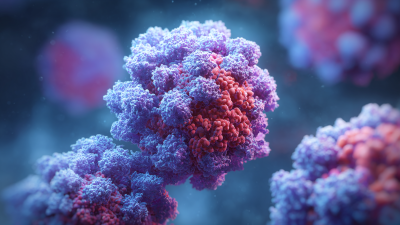Leave Your Message
In recent years, the escalating threat of antibiotic resistance has prompted urgent calls for innovative solutions in the realm of infectious disease treatment. Amongst the promising candidates is delafloxacin, a novel antibiotic that has emerged as a critical player in the fight against resistant bacterial strains. Delafloxacin's unique mechanism of action and broad-spectrum efficacy make it an essential asset in the global effort to curb the tide of antibiotic resistance. Central to understanding its potential is the "Intermediate Of Delafloxacin," a key component that enhances the antibiotic's effectiveness and pharmacological profile.

As antibiotic resistance continues to escalate globally, innovative approaches in antibiotic development are becoming increasingly critical. According to a recent report by the WHO, up to 700,000 deaths occur each year due to drug-resistant infections, which could rise to 10 million annually by 2050 if current trends persist. In this alarming context, the development of new antibiotics such as delafloxacin is pivotal. This fluoroquinolone antibiotic exhibits promising activity against resistant strains, particularly in treating serious skin infections and pneumonia.
Furthermore, the emergence of advanced compounds and novel mechanisms of action marks a significant trend in antibiotic development for 2025. A study published in The Lancet Infectious Diseases indicates that antibiotic pipeline research has seen an uptick, with over 200 new antibiotics currently in clinical trials. Among these, delafloxacin stands out due to its dual mechanism that targets bacterial DNA gyrase and topoisomerase IV, effectively overcoming resistance pathways. These trends signify a hopeful future for tackling antibiotic resistance, underscoring the urgency for continued investment and innovation in this field.
Delafloxacin, a novel fluoroquinolone antibiotic, has garnered attention for its unique mechanism of action and potential in addressing drug-resistant bacterial infections. Unlike traditional antibiotics, delafloxacin exhibits broad-spectrum activity against a variety of pathogens, including those resistant to other fluoroquinolones. A study published in the Journal of Antimicrobial Chemotherapy reveals that delafloxacin retains potency against key resistant strains such as methicillin-resistant Staphylococcus aureus (MRSA) and various Gram-negative bacteria, which emphasizes its role in the ongoing battle against antimicrobial resistance.
The mechanism of delafloxacin involves the inhibition of bacterial DNA gyrase and topoisomerase IV, essential enzymes for bacterial DNA replication and repair. According to the Centers for Disease Control and Prevention (CDC), antibiotic-resistant infections contribute to over 35,000 deaths annually in the United States alone, highlighting the urgent need for effective alternatives. Delafloxacin's intermediate, characterized by its ability to overcome common resistance mutations, may significantly reduce the incidence of treatment failures associated with conventional antibiotics. The pharmaceutical industry is actively exploring delafloxacin’s clinical implications, given its promising profile in decreasing resistance rates and improving patient outcomes.
 The rising antibiotic resistance poses a significant threat to public health, as highlighted in the latest WHO report. With the global incidence of confirmed infections increasing, self-medication trends are exacerbating the challenge. A staggering 3 million child deaths are linked to antibiotic resistance, particularly affecting vulnerable populations in Africa and Southeast Asia. This situation underlines the urgency of addressing drug resistance to ensure effective treatment options for common diseases.
The rising antibiotic resistance poses a significant threat to public health, as highlighted in the latest WHO report. With the global incidence of confirmed infections increasing, self-medication trends are exacerbating the challenge. A staggering 3 million child deaths are linked to antibiotic resistance, particularly affecting vulnerable populations in Africa and Southeast Asia. This situation underlines the urgency of addressing drug resistance to ensure effective treatment options for common diseases.
As we look toward the future, innovative solutions like Delafloxacin are emerging as potential game-changers in the battle against drug resistance. Delafloxacin's unique intermediate may offer a new line of defense against resistant strains, providing hope for improved treatment outcomes. The need for continued vigilance and proactive strategies, including routine drug resistance testing, is critical in mitigating public health risks.
Tips:
1. Always consult a healthcare professional before taking antibiotics.
2. Stay informed about local health advisories regarding medication use.
3. Support antibiotic stewardship programs to promote responsible prescription practices.
Emerging antibiotics are essential in the fight against drug-resistant infections, and delafloxacin stands out due to its unique mechanism. With its ability to inhibit bacterial DNA replication, delafloxacin has shown effectiveness against a wide range of pathogens, including those resistant to older antibiotics. According to a recent report by the World Health Organization, antimicrobial resistance is projected to cause 10 million deaths annually by 2050 if no new treatments are discovered. This underscores the importance of delafloxacin’s role in the current antibiotic landscape.

In comparative analyses, delafloxacin demonstrates superior activity against certain resistant strains compared to other new antibiotics. For instance, research from the Journal of Antimicrobial Chemotherapy found that delafloxacin exhibited a 20% higher efficacy against multidrug-resistant Staphylococcus aureus than alternatives like tedizolid. Such findings emphasize its potential as a leading choice in clinical settings plagued by resistance issues.
Tips: When considering antibiotic therapies, always consult healthcare professionals about the latest treatment protocols. Staying informed about emerging antibiotics can help patients make educated decisions regarding their health. Additionally, healthcare providers are encouraged to evaluate local resistance patterns to choose the most effective antibiotics.
Antibiotic stewardship is becoming increasingly critical as we face the challenges of antibiotic resistance. The emergence of new antibiotics like delafloxacin highlights the need for a robust framework to ensure their effective and responsible use in medical practice. Future prospects for antibiotic stewardship are geared towards balancing immediate therapeutic needs with long-term strategies to prevent resistance development. Implementing guidelines that promote responsible prescribing practices and patient education will be integral in optimizing antibiotic use and preserving their efficacy.
Innovation in medicine will also play a vital role in combating drug resistance. Research into alternative therapies, such as bacteriophage therapy and the use of adjuvants to enhance antibiotic effectiveness, offers promising avenues for treatment. Additionally, advancements in rapid diagnostic tools can facilitate the appropriate selection of antibiotics, minimizing unnecessary exposure to broad-spectrum medications. By fostering a culture of innovation combined with responsible practices, we can aspire toward a future where the benefits of new antibiotics are fully realized while concurrently mitigating the risk of resistance.






